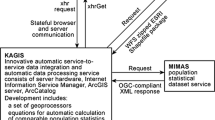Abstract
Current ready-made geospatial information (GI) production method of National Geographic Information Institute causes issues, including duplications and inconsistencies of data, and low customer satisfaction. This study suggests concept, framework, approach, and strategy for mass customization of GI to tackle the current production method. First, this study defines mass customization of GI as “a method of producing and providing GI that reflects customer needs, based on modularized and standardized geospatial data as source data”. It is to develop modularized and standardized National Geospatial Data (NGD) based on object-oriented database, using this as source data to produce and provide multi-services of GI. Second, this study suggests three phases (i.e., development/update, management/combination, customization/provision) and seven unit tasks (i.e., data acquisition/synchronization, security management, data maintenance, specification-oriented combination, demand survey, demand-oriented combination) as approach to implement mass customization of GI. Third, this study suggests strategy for GI mass customization, including modularization and standardization of NGD and production process, and customization. Fourth, this study confirms high feasibility of the approach and strategy, through discussion on sufficient condition, success factor, and goal achievement for GI mass customization. This study has implication in shifting paradigm of GI production method from ready-made to customization.


Similar content being viewed by others
Notes
NGII is a national agency that establishes and provides national location standards and maps (digital map).
A topographic map that expresses the whole country in one piece map by connecting the topographic maps of map sheet unit to the whole country.
A map in pdf format with topographic map and orthographic image superimposed.
A map of map tile format using a seamless digital topography map.
Administrative boundaries, buildings, roads, railways, structures, topography, water systems, etc.
For example, the change rate of a seamless digital topographic map is less than 5% of the previous year.
The change in a product means the change in the standard product.
The change in an expression method means the change in the appearance of the standard product or the change in the form of the supplementary service.
SCP DB and NGN DB are DBs of the unit information system that supports survey reference point management and national place name management, respectively, and some of them are extracted to create survey reference points and POIs of the theme GI that constitutes national geospatial data.
Security management is not specifically described, because it is not related to mass customization.
References
https://www.ordnancesurvey.co.uk/business-and-government/licensing/partners/consumer-solutions-contract.html. Accessed 1 Feb 2018.
Hwang, C. S. (1999). A experimental study on the translation from Korean digital topographic maps to distributed objects. Spatial Information Research, 7(2), 255–269.
Kim, H. S., Kim, S. Y., Lee, Y. K., Seo, S. B., Park, K. S., & Ryu, K. H. (2009). Spatial data model of feature-based digital map using UFID. Spatial Information Research, 11(1), 146–153.
Jo, J. R., Shin, S. C., Kwon, C. O., & Jin, H. C. (2011). Design on the system and OSID structure for managing object-based seamless digital map. Spatial Information Research, 19(3), 73–81.
Shin, H. A., Jeon, H. K., Lee, W. J., & Kang, Y. J. (2012). Exploring case study on mass customization of domestic company. Journal of Digital Convergence, 10(6), 111–131.
Pine, B. J., II. (1993). Mass customization: The new frontier in business competition. Boston, MA: Harvard Business School Press.
Im, B. H., & Cho, H. H. (2005). Determining critical success factors for mass customization in supply chain management perspective: Based on ANP(Analytic Network Process). Comment of Hankuk University of Foreign Studies, 31, 91–117.
Lampel, J., & Mintzberg, H. (1996). Customizing customization. Sloan Management Review, 38(1), 21–30.
Gilmore, J. H., & Pine, B. J., II. (1997). The four faces of mass customization. Harvard Business Review, 75(1), 91–101.
Duray, R., Ward, P. T., Milligan, G. W., & Bery, W. L. (2000). Approaches to mass customization: configuration and empirical validation. Journal of Operation Management, 18(6), 605–625.
Swaminathan, J. M. (2001). Enabling customization using standardized operations. California Management Review, 43(3), 125–135.
National Geographic Information Institute, 2017, National Geospatial Data Standard.
National Geographic Information Institute, 2017, Study on New-National Base Map System.
Author information
Authors and Affiliations
Corresponding author
Rights and permissions
About this article
Cite this article
Choe, B., Lee, Sh. & Lee, Tk. Innovative strategy toward mass customization of geospatial information: the case of National Geographic Information Institute in South Korea. Spat. Inf. Res. 27, 309–315 (2019). https://doi.org/10.1007/s41324-019-00238-4
Received:
Revised:
Accepted:
Published:
Issue Date:
DOI: https://doi.org/10.1007/s41324-019-00238-4




